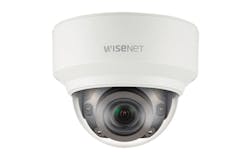Hanwha Techwin America on Friday launched its most advanced chipset to date, Wisenet 5, and also announced that it would be removing the Samsung branding on the new X series line of cameras that will be powered by it.
According to Tom Cook, vice president of sales for North America at Hanwha, the branding on the company’s cameras will transition from Samsung to Wisenet, which he says is now well-known in the marketplace.
"Our co-branding has been going on for the last four or five years of Samsung powered by Wisenet… so at this point we’ve decided Wisenet has become a strong enough name that we’re going to start utilizing it as our brand for our cameras," Cook says. "It will start with the X series immediately and follow through in the future on all new products. We will ultimately fade out the Samsung name as we go in time."
A New Level of Video Quality
Cook says the new Wisenet 5 chipset will "define a new standard" in the industry when it comes to video surveillance technology. It will be available in the company's new Wisenet X series camera line, which boasts 27 different models that will support a mix of both 2-megapixel and 5-megapixel resolution cameras. Cook says what really separates the capabilities of the Wisenet 5 chips in the X series from previous generations is its Wide Dynamic Range (WDR) decibel (dB) level and data compression capabilities.
The standard WDR performance on the new 2-megapixel cameras models will be 150dB. Cook says the best that most cameras available on the market today can offer is about 120dB.
"With the technology of a 60 (frames-per-second) camera today, you basically take the light and the dark exposure and you take 30 frames of light and 30 frames of dark and you fuse those frames together thus getting a 30fps camera with a Wide Dynamic Range of approximately 120dB. If you use a regular 30fps camera with digital you can probably only get about 60dB or 70dB," Cook explains. "Many companies have gotten to that point that we had back in 2013 (with the launch of Wisenet 3) and we’re now using this chipset – it’s basically 120fps camera chipset that allows us to take four images, a long exposure, a short exposure, a medium exposure and an even longer exposure, giving you four pictures fused into one frame."
Additionally, Cook says the same camera could be placed in a 60fps mode and get 120dB performance. "If you compare that to what’s in the market today, there’s no camera that 60fps with 120dB, they all have to drop down to 30fps," he says.
This means that there will be no ghosting or wobble effect in the images for end-users, resulting in more fluid video footage.
According to Hanwha, data compression is another major point of differentiation it is striving to achieve. While the industry has yet to move en masse to H.265, Cook says they not only have the ability to support it but to also improve upon it when it is used in conjunction with their proprietary WiseStream II technology. Cook says those using H.265 compression alone can achieve 50 percent better compression; however, when combined with WiseStream II, users could see as much as a 99 percent savings in bandwidth.
"WiseStream II takes (compression) to another level by adding two new features into the data compression algorithm. One is a Low Pass filter that basically eliminates noise which creates a lot of data on the video. We’ve introduced another algorithm called Dynamic Frames per second, which allows us, if there is no motion in the field of view at all, to drop out the actual P frame completely," Cook says.
Among some of the other new features of the new Wisenet X series cameras include:
- Monitoring of color images in low-light environments. Leveraging the Wisenet 5 chipset, X series cameras produce images that can be monitored in color even in low-light environments without IR LED, which enables vivid images to be captured regardless of the environment or time of day.
- USB port for added convenience. Using the USB port, Wisenet X series cameras allows for certain adjustments (i.e. focus, viewing angle) directly from mobile devices via Wi-Fi and wired. Installers can reduce installation time, dramatically reducing costs.
- More diverse analytics. The Wisenet X series offers license-free analytics. The audio analysis function recognizes critical sounds, such as gunshots, explosions, screams, and broken glass, and then immediately issues an alarm. Additional analytics include queue management which analyzes queues generated in specific environments such as a shop or bank for more efficient management.
- Dual SD card slots. Dual SD card slots allow up to 512GB of video to be saved automatically on-board the camera, to preserve data in the event of a network disruption.
- More accurate stabilization. Gyro sensors have been added to the technology used in existing cameras for more accurate stabilization.
Cook emphasizes that while the new X series will be "competitively priced," Hanwha is not going to be entering the race to the bottom that has occurred in recent years throughout the industry.
"What we found is if we do our development right, the people – end-users, consultants and others that we work with – want better solutions. The products are very competitively priced but they are giving the customers the solutions that they need," he says.


